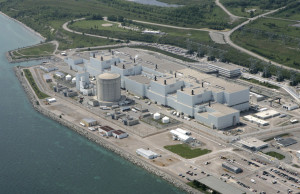January 23: Back in the 60’s, I went all Greenpeace over the issues around the proposed construction of nuclear power plants in Ontario. Leaving aside nagging questions about the safety of the technology, there were two issues that I didn’t feel were resolved: Firstly, there was the question of how the spent nuclear fuel would be transported and stored long-term, and secondly, there was the cost of the program which was staggering, even in 60’s era dollars.
Some 40 years later, there is still no clear solution in sight to the question of secure storage. The current front-runner seems to be deep disposal in a location that may or may not compromise the Great Lakes. We are in a push-pull between a municipality which sees the storage proposal as a longer-term employment opportunity, versus the potential environmental damage which must be assumed by the greater public over the next 1000 years or so. Whatever the case, there’s still no answer.

The initial cost of constructing Darlington and Bruce was truly staggering and they have only gotten more expensive. ( The final cost of Darlington alone was roughly $14 Billion. ) Hydro users are still paying a “debt retirement charge” on every monthly bill for their construction, and several weeks ago, the Province decided to fund about $25 Billion in repairs and maintenance for the existing nukes.
Granted, the nuclear industry provides roughly 30,000 jobs (direct and indirect) across Canada*, and nuclear plants provide almost half of the Provincial electricity, but I have often wondered what alternative future might have arisen had the Province decided to spend even a fraction of the initial budget of the nuclear program on the development of alternative energy sources. With that 30 or 40 year head start, we might now be in a leadership position in alternative industries. Instead, we put all our eggs in the basket of an expensive, complex and ultimately unsustainable technology. We seem to have painted ourselves into the corner of having to shore up nukes until other sources of energy can be developed.
Similarly, we are facing an economic downturn brought on by our reliance on fossil fuels, particularly oil. I don’t think there is any doubt that we are seeing the end of carbon-based fuels, yet we can’t seem to get beyond the urge to yank the stuff out of the ground and send it down a pipe to another country for processing. Surely there is an opportunity now to think differently and invest in other sectors – perhaps bio-medical research or aerospace – that might make a long-term contribution to a more sustainable Canadian economy and move us away from being “hewers of wood and drawers of water”. If it keeps going this way, I may have to dig out my Greenpeace T-shirt.
* By comparison, the auto parts industry, based largely in Ontario, had a 2008 employment of roughly 100,000.
*******
Or there’s this February Report on Business article by Eric Reguly:
http://www.theglobeandmail.com/report-on-business/rob-magazine/running-on-empty-bp-needs-to-revisit-green-approach/article28397699/